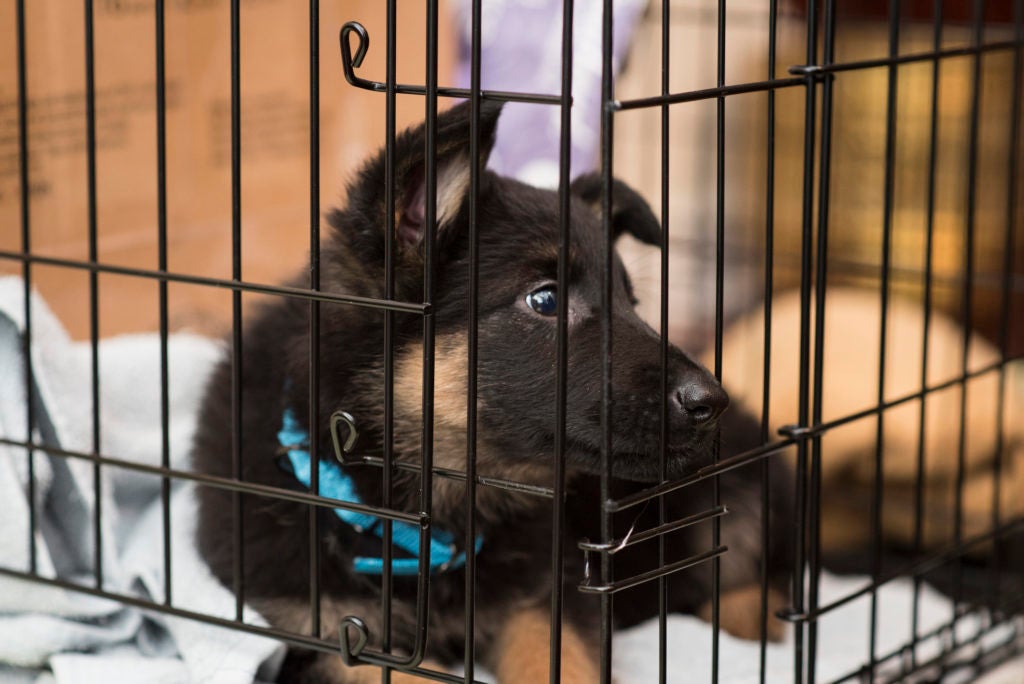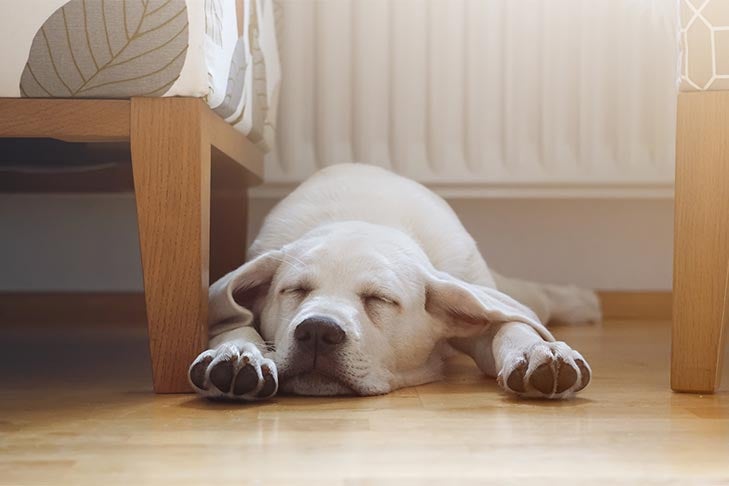AKC is a participant in affiliate advertising programs designed to provide a means for sites to earn advertising fees by advertising and linking to akc.org. If you purchase a product through this article, we may receive a portion of the sale.
When you first get a puppy, there is so much to do to introduce them to their new home. From potty training to puppy-proofing, you might feel like your hands are full. But there is one critical step you don’t want to forget — teaching your pup how to enjoy being alone. Although it’s tempting to spend every waking minute with your new puppy, you aren’t doing them any favors. Eventually, you’ll have to leave them on their own. And because dogs are incredibly social creatures, leaving a puppy alone can be stressful. However, with a little time and effort, you can ensure they’re calm and confident whenever they are by themselves.
Using a Safe Confinement Area
It’s likely your new puppy has never been alone before. It’s unfair to expect them to go from constant companionship to spending an entire eight-hour workday on their own. Start by teaching them to be alone while you are still in the house. A safe confinement area, like an exercise pen or crate, is perfect for this purpose. If you use a crate or exercise pen appropriately, they will see their confinement area as a place to relax rather than as punishment. Alternatively, you can limit your puppy to a small and safe area with baby gates.
To help your puppy associate this space with good things, feed them meals inside it. If the area is large enough, you can also spend some time playing in there together. To entice your puppy, set aside special toys they only get inside their crate or pen. When they’re happy to enter the confinement area on their own, you’re ready to start alone-time training.
Teaching Alone Time
Begin by closing your puppy in the confinement area with a chew toy or other constructive activity, then quietly walk out of the room. Return immediately and reward them with praise and a treat. Repeat the process, slowly increasing how long you’re away each time. In the beginning, even one or two minutes might feel too long for your puppy, but over three or four days, you should be able to build up to fairly long periods.
As the time span increases, return to check on your puppy periodically. If they are quiet and calm, reward them with low-key praise and a treat before leaving to continue the countdown. Don’t make too much fuss when you check on them. You don’t want your puppy to miss you when you leave the room.
If your puppy is crying in their confinement area, you’ve likely started the training before they’ve learned to associate the area with good things, or you’ve left them alone for too long. Don’t make a habit of letting them out when they fuss. Otherwise, you will teach them that whining opens the door and earns attention. Instead, shorten their time in the confinement area to what they can handle, and build the time more slowly.
Remember that confinement in the exercise pen or crate is only temporary while you work on your puppy’s alone time training. Once your puppy is confident on their own, and they understand potty training and the rules of good behavior, you can start giving them access to your home while you are away, one room at a time. The goal is an adult dog that is relaxed, self-assured, and can be trusted with more freedom.

Creating Happy Associations
Leaving a puppy alone with nothing to do in their safe area can be a recipe for trouble. Instead, give them something constructive to do whenever they’re in confinement. This will teach them to be happy on their own. A perfect activity is chewing on a chew toy stuffed with food. Toys such as Kongs are excellent for this purpose because the food coming out of the toy will reinforce the chewing behavior. In time, you will end up with a chew toy addict who would rather chomp on their toys than the baseboards.
Other ways to keep your puppy busy when they are alone include providing edible chews like bully sticks or yak milk chews, leaving food hidden around the confinement area, or providing food-releasing puzzle toys. However, only leave your puppy unattended with toys, or edible chews that you know are safe. For example, smaller objects that your puppy can fit completely inside their mouth are a choking hazard. Or objects that can splinter or be broken into small pieces can cause intestinal damage or obstruction if swallowed. Speak to your veterinarian about safe options, and always watch your puppy with any new toy until you are sure they can play with it safely.
When leaving a puppy alone, you can also use a sound machine or heartbeat pillow to provide company. The noise can cover up other sounds that might be more distressing, like honking cars or the garbage truck. In fact, a study from Colorado State University found that music influenced the behavior of dogs in a shelter. However, the effect was dependent on the type of music. Heavy metal music seemed to increase the dogs’ anxiety, whereas soothing classical music like Moonlight Sonata increased the amount of time the dogs spent sleeping. So, select your background noise with care, and watch your puppy to see how they react to your choice.
Looking for Help Along the Way
If you’re unable to spend time at home with your puppy, consider finding a puppy sitter to help you work on their alone-time training. You can hire a professional pet sitter to watch your dog. Or perhaps look for a neighbor or friend who might be happy to relax in your house while your puppy rests in their confinement area. Even better, your puppy sitter can help with your puppy’s potty training and give them lots of attention in between confinement sessions.
When your puppy’s alone time training has progressed enough that you can leave them alone for part of the day, but eight hours is still too much, a dog walker can be a perfect solution. Schedule the walk in the middle of the day, when your puppy is ready for company and the time is ripe for a potty break. Even adult dogs can benefit greatly from the exercise and company a dog walker provides during a workday.
Finally, consider providing your puppy with a physical or mental workout before you leave them alone. A walk, energetic playtime, or even a training session can all leave your puppy tired. They will likely fall asleep as soon as you’re gone. Just be sure that you do the same activities at other times too. If your dog only gets that sort of attention right before you leave them alone, they’ll realize it means you’re about to go. So, rather than lying down for a nap, they might worry about your absence.

Enjoying the Benefits
A dog that hasn’t learned to enjoy time by themself can exhibit problem behaviors when left alone. At best, an untrained solitary puppy will make their own fun, and no doubt in ways that aren’t fun for you. At worst, they can develop separation anxiety. This is a serious condition where the dog is severely stressed from the moment you leave until you finally return.
On the other hand, teaching your puppy that enjoyable things happen when they are alone will help them handle not being the center of attention, even when you are at home. In fact, they should look forward to being on their own because they associate it with chew toys and treats. But most importantly, because you’ve taught them to be alone even when you’re simply in another room, they won’t connect you leaving the house with being alone. You should be able to head to work or the grocery store without worry.
Teaching your puppy to enjoy alone time will also contribute to important training milestones like passing the AKC S.T.A.R. Puppy test. The AKC S.T.A.R. Puppy Program is designed to get puppies and their owners off to a good start, and the test includes an isolation exercise. Puppies must stay on a leash with another person while their owner walks 10 steps away before returning. That’s great preparation for the AKC’s Canine Good Citizen (CGC) test, the gold standard of behavior for dogs in our society. The supervised separation part of the CGC test requires an owner to leave their dog with a trusted person for three minutes while they are out of sight. This will be a piece of cake for the dog that has been trained to enjoy being alone.
The AKC is here to help owners with questions and concerns about COVID-19 and dogs. Find answers to your questions, plus at-home activity ideas, training tips, educational resources, and more on our Coping With COVID-19 hub.

